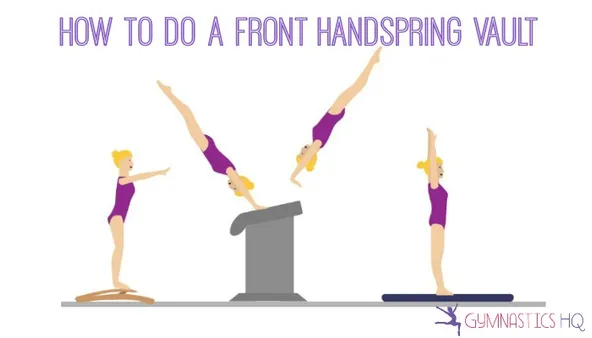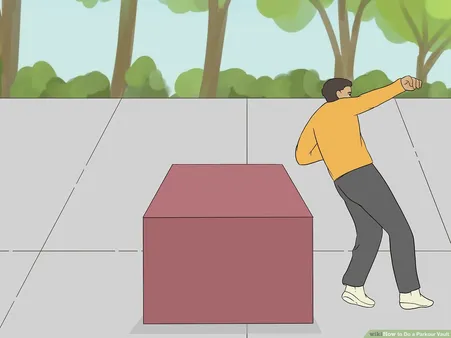Table of Contents
Are you ready to take your athleticism to new heights? Vaulting is an exhilarating sport that combines power, agility, and grace. Whether you're a seasoned athlete or just starting, our comprehensive guide will teach you How to do a vault like a pro. With our step-by-step instructions, tips, and common mistakes to avoid, you'll be soaring over obstacles in no time. So, lace up your shoes, warm up your muscles, and get ready to learn how to do a vault with Kizworld.
How to do a vault: A step-by-step guide for beginners
I. How to Do a Vault: A Step-by-Step Guide
How to Do a Vault: A Step-by-Step Guide
1. Approach the Vault
Begin by standing a few steps away from the vault, with your feet shoulder-width apart and your knees slightly bent. Your arms should be at your sides, with your hands relaxed. As you approach the vault, gradually increase your speed until you are running at a moderate pace.
As you get closer to the vault, take a few quick steps to build up momentum. Just before you reach the vault, jump up into the air, extending your legs and arms fully. Your body should be straight and your toes should be pointed.
Mistake | How to Avoid It |
Approaching the vault too slowly | Build up momentum as you approach the vault by taking a few quick steps before you jump. |
Jumping too early or too late | Time your jump so that you reach the vault at the peak of your jump. |
Not extending your legs and arms fully | Extend your legs and arms fully as you jump to generate power and height. |
Landing on your heels | Land on the balls of your feet and roll through your landing to absorb the impact. |
2. Take Off
As you reach the peak of your jump, push off the ground with your feet and extend your body fully. Your arms should be extended in front of you, and your legs should be straight. Your body should be in a straight line from your head to your toes.
As you push off, focus on generating power and height. Your goal is to reach the top of the vault and clear the bar.
3. Push Off
Once you have reached the top of the vault, push off with your hands and extend your body fully. Your arms should be straight and your legs should be extended behind you. Your body should be in a straight line from your head to your toes.
As you push off, focus on generating power and distance. Your goal is to land safely on the other side of the vault.
4. Flight
As you push off, you will be in the air for a brief moment. During this time, your body should be in a straight line from your head to your toes. Your arms should be extended in front of you, and your legs should be extended behind you.
Focus on maintaining your balance and control as you fly through the air. Keep your core engaged and your eyes focused on the landing area.
5. Landing
As you approach the landing area, bend your knees and ankles to absorb the impact. Your feet should land shoulder-width apart, with your toes pointed slightly outward. Your arms should be extended in front of you, and your body should be in a slight crouch.
As you land, roll through your feet and come to a controlled stop. Your goal is to land safely and avoid any injuries.
II. Tips for Vaulting Like a Pro
- Practice regularly to improve your technique and build muscle memory.
- Start with a lower vault and gradually increase the height as you become more comfortable.
- Focus on generating power and height as you push off the ground and extend your body.
- Maintain your balance and control throughout the vault, from the approach to the landing.
- Land softly and roll through your feet to absorb the impact.
With practice and dedication, you can learn to vault like a pro and enjoy the thrill of this exciting sport.
III. Mastering the Vault: Techniques and Tips
Mastering the Vault: Techniques and Tips
Perfecting Your Approach
A successful vault begins with a well-executed approach. As you run towards the vault, maintain a steady pace and focus on your form. Keep your body straight and your arms relaxed at your sides. As you approach the vault, take a few quick steps to build momentum and then plant your feet firmly on the ground just before the vault.
Tip: Practice your approach by running towards a cone or other marker placed a few feet away from a wall. Focus on maintaining a steady pace and planting your feet firmly on the ground.
- Related: How to Do a Handstand: A Step-by-Step Guide for Beginners
- Related: The Benefits of Gymnastics for Kids: Building Strength, Flexibility, and Confidence
Mastering the Take Off
The take off is the most critical part of the vault. As you approach the vault, swing your arms forward and upward to generate momentum. As you plant your feet on the ground, push off powerfully with your legs and extend your body upward. Keep your arms extended and your body straight as you leave the ground.
Tip: To improve your take off, practice jumping vertically without a vault. Focus on generating power from your legs and extending your body fully.
Common Mistakes | How to Avoid Them |
|---|---|
Taking off too early or too late | Practice your timing by jumping over a series of cones or markers placed at different distances from the vault. |
Not generating enough power | Strengthen your legs by doing exercises such as squats, lunges, and calf raises. |
Not extending your body fully | Practice jumping vertically without a vault, focusing on extending your body fully. |
Conquering the Flight Phase
Once you have taken off, you will enter the flight phase of the vault. During this phase, your body will be in the air and you will need to control your movement to land safely. Keep your body straight and your arms extended. As you approach the landing, tuck your knees towards your chest and prepare to land on your feet.
Tip: To improve your flight phase, practice jumping over a series of obstacles, such as cones or hurdles. Focus on controlling your body and landing safely.
- Related: The Best Gymnastics Equipment for Home Use: Creating a Safe and Fun Training Space
- Related: How to Improve Your Flexibility and Mobility with Gymnastics: Stretching Exercises and Techniques
Sticking the Landing
The landing is the final and most important part of the vault. As you approach the landing, tuck your knees towards your chest and prepare to land on your feet. Keep your body straight and your arms extended as you land. As soon as your feet hit the ground, absorb the impact by bending your knees and ankles. Step forward to maintain your balance and complete the vault.
Tip: To improve your landing, practice landing on a soft surface, such as a mat or a pile of pillows. Focus on keeping your body straight and absorbing the impact with your knees and ankles.
- Related: The History and Evolution of Gymnastics: From Ancient Greece to the Modern Olympics
- Related: How to Choose the Right Gymnastics Leotard: Finding the Perfect Fit and Style
IV. Common Mistakes to Avoid When Vaulting
Common Mistakes to Avoid When Vaulting
To ensure a safe and successful vault, it's crucial to avoid common mistakes that can hinder your performance or lead to injuries. Here are some key mistakes to watch out for:
- Insufficient Warm-Up: Neglecting a proper warm-up can increase the risk of muscle strains or injuries. Ensure you engage in dynamic stretches and light cardio to prepare your body for the vault.
- Incorrect Approach: Approaching the vault at an improper angle or speed can affect your takeoff and flight. Maintain a straight and controlled approach, focusing on generating momentum.
- Poor Hand Placement: Improper hand placement on the vault can result in a loss of balance or control. Ensure your hands are shoulder-width apart and firmly planted on the vault, creating a stable base for your takeoff.
- Incomplete Push-Off: A weak or incomplete push-off can limit your height and distance during the vault. Drive your legs powerfully off the ground, extending them fully to generate maximum propulsion.
- Over-Rotation: Excessive rotation during the flight phase can lead to a loss of control and a hard landing. Focus on maintaining a controlled and balanced rotation, aiming for a smooth landing.
- Improper Landing: A poor landing technique can increase the risk of injuries. Bend your knees and absorb the impact with your legs, aiming for a soft and controlled landing.
By avoiding these common mistakes and focusing on proper technique, you can improve your vaulting skills, minimize the risk of injuries, and achieve greater success in your vaulting endeavors.
To further enhance your vaulting skills, consider these additional tips:
- Practice Regularly: Consistent practice is key to mastering the vault. Dedicate time to regular training sessions, focusing on improving your technique and building muscle memory.
- Seek Coaching: Working with a qualified coach can provide valuable guidance and feedback, helping you identify areas for improvement and refine your vaulting technique.
- Strength and Conditioning: Incorporate strength and conditioning exercises into your training routine to build the necessary muscle strength and power for effective vaulting.
- Proper Equipment: Ensure you have the appropriate equipment, including a well-maintained vault and suitable footwear, to support your vaulting practice.
- Safety First: Always prioritize safety during your vaulting sessions. Use spotters when attempting new or challenging vaults, and follow proper safety protocols to minimize the risk of injuries.
By following these tips and avoiding common mistakes, you can elevate your vaulting skills and achieve your athletic goals.
For more insights and guidance on vaulting, explore our related articles:
- How to Do a Handstand: A Step-by-Step Guide for Beginners
- The Benefits of Gymnastics for Kids: Building Strength, Flexibility, and Confidence
- The Best Gymnastics Equipment for Home Use: Creating a Safe and Fun Training Space
V. Safety Precautions for Vaulting
Safety Precautions for Vaulting
The thrill of soaring over obstacles in a vault is undeniable, but safety must always come first. Here are some crucial precautions to take:
Warm Up Properly
- Start with light cardio exercises to elevate your heart rate and blood flow.
- Perform dynamic stretches to enhance flexibility and range of motion.
- Focus on stretching the muscles used in vaulting, such as calves, hamstrings, and hip flexors.
Don't forget to check our guide on improving flexibility and mobility for gymnastics for a comprehensive warm-up routine.
Wear Appropriate Clothing and Footwear
- Opt for clothing that allows free movement, such as stretchy leggings and a form-fitting top.
- Ensure your shoes have good grip and support to prevent slipping during the takeoff.
- Consider investing in specialized gymnastics shoes for optimal performance.
For more insights, read our article on choosing the right gymnastics leotard and selecting the best gymnastics shoes and grips.
Inspect the Vaulting Apparatus Thoroughly
- Check the vaulting horse for any damage or loose parts that could cause injury.
- Ensure the vaulting mat is properly placed and secured to prevent shifting during the landing.
- Report any potential safety hazards to your coach or gym staff immediately.
Refer to our guide to choosing the best gymnastics mats for detailed information on mat safety.
Master the Basic Techniques
- Begin by practicing the approach, takeoff, and landing techniques separately.
- Focus on maintaining proper body position and alignment throughout each phase of the vault.
- Work with a qualified coach to receive personalized instruction and feedback.
Our comprehensive guide on how to do a vault provides step-by-step instructions and tips.
Progress Gradually
- Start with simple vaults and gradually increase the difficulty as you gain confidence and skill.
- Don't rush the process; allow your body time to adapt and develop the necessary strength and coordination.
- Avoid attempting advanced vaults without proper training and supervision.
For a structured approach to vaulting progression, refer to our article on mastering the basic gymnastics skills.
Stay Hydrated and Energized
- Drink plenty of water before, during, and after your vaulting sessions to prevent dehydration.
- Consume a balanced diet that provides adequate energy and nutrients for your training needs.
- Avoid sugary drinks and processed foods that can lead to fatigue and decreased performance.
Check out our guide on gymnastics nutrition and hydration for a more in-depth look at this topic.
Listen to Your Body
- Pay attention to any signs of pain or discomfort during or after vaulting.
- Take breaks when needed to prevent injuries and allow your body to recover.
- Consult with your coach or a healthcare professional if you experience persistent pain or discomfort.
Remember, vaulting is a demanding sport that requires proper training and safety precautions. By following these guidelines, you can minimize the risk of injury and enjoy the sport safely and effectively.
VI. Conclusion
Vaulting is an exciting and challenging sport that requires a combination of strength, agility, and coordination. With consistent practice and dedication, you can master the technique and soar over obstacles with grace and ease. Remember to prioritize safety by warming up properly, choosing an appropriate vaulting height, and practicing under the supervision of an experienced coach. As you progress in your vaulting journey, continue to refine your technique, push your limits, and enjoy the thrill of flying through the air. Whether you're competing in track and field or simply looking to add a new skill to your repertoire, vaulting is an exhilarating sport that will bring you a sense of accomplishment and satisfaction.